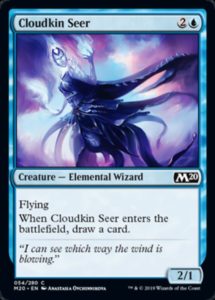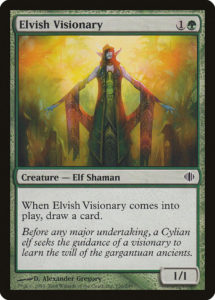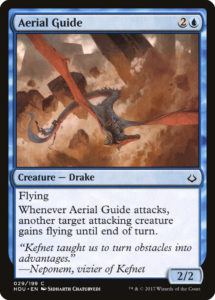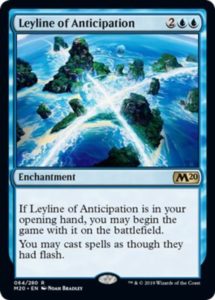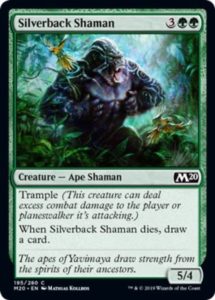The summer of Magic continues with Core 2020 prerelease this weekend. Even more so than last year, the Core Set features a slew of powerful Constructed cards, a potpourri of strong introductory play options, and a Limited format that’s . . . wait . . . what is that?
Oh. Oh. Oh my.
Is anyone else seeing that? This thing is a common! Yeah, I know Murder and Disfigure are back at common, but we’ve literally never seen something like this before. It’s an aggressively-costed cantripping creature. With evasion. A few months ago, Play Design went on record to say they were going to make more exciting commons starting with War of the Spark; so while Cloudkin Seer isn’t out of the monoblue, it’s still shockingly powerful.
Today, we’re going to dive into this novel yet simple design to see just how much it tells us about Core 2020 and how Magic’s design may have changed since the advent of Play Design.
Developing Cantrip Creatures
There’s a well-documented track record that making something cantrip (draw a card in addition to something else) tends to cost two mana. Elvish Visionary is an excellent example of this: a one mana 1/1 is worth less than a mana, so stapling a cantrip to a zero-mana creature yields a two-mana creature. Mix with an extremely relevant creature type and you’ve got something solid in Limited and very powerful in Constructed.
Push the power level just a tiny bit more and you get Striped Bears and Nimble Innovator. This also makes sense, since a two mana 2/2 plus a two mana cantrip yields a four-drop. Now, neither of these are particularly pushed—you can get more for two mana than just a 2/2, and Phyrexian Rager has been around for almost twenty years. That said, push it even harder and you’ve got Rogue Refiner, which is too much.
Normally, Cloudkin Seer would cost four or even five mana, but the rules have changed. A 2/1 flying creature (especially a common) costs between two mana (usually with a restriction, like only being able to block flying creatures) and three mana (with room for extra benefits). We have seen Stormfront Pegasus as basically the top end of what two mana will get you on a common, so that’s our baseline. A cantrip costs two, so we’re looking at four mana minimum—again, Stormfront Pegasus is a very mana efficient card, so it’s not like we could easily round down the cantrip’s cost to one mana. And yet that’s exactly what happened.
Play Design is the reason that Cloudkin Seer exists. They’ve proven themselves able to take risks and push boundaries while properly evaluating the effects of those actions and the state of the metagame. For years, we’ve seen the power of common creatures steadily increase while flying creatures lagged behind, especially in aggressive formats (something we wrote about two years ago). If they’d made Cloudkin Seer a four drop, it’d have followed established convention; but it wouldn’t be a particularly good card. So instead, they’re experimenting with knocking a mana off and making it into a likely amazing card. I trust Play Design to know what they’re doing, and that is make not only an outstanding blue common, but one that lies at the intersection of all three blue archetypes.
Three for Three Archetypes
Core 2020 has five archetypes of varying cohesion spread across the five wedges (a color and its two enemies). They are:
WBG Go Wide (a loose theme)
URW Flying Creatures (a medium tribal theme)
BGU ETB Effects (a very loose theme)
RWB Aggro (a loose theme)
GUR Elementals (a strong tribal theme)
Cloudkin Seer is a flying elemental with an ETB effect. It was already a top tier common creature just on its power level alone, but it gets a bump for also interacting positively with every kind of blue deck. This is a solid bit of lenticular design (the card is even better than it initially looks once you realize how good it is in the format) that will give players added appreciation for Cloudkin Seer once they start recognizing the format’s synergies. That’s a good way to get less experienced players feeling smart, having fun, and learning as they play while giving more experienced players a leg up in the format.
The Environment
Given that Cloudkin Seer and Murder exist at common, it’s unsurprising just how stellar other colors’ commons are as well. Green has access to Thicket Crasher (a 4/3 trample with upside), Silverback Shaman (a 5/4 trample with upside), and Rabid Bite (one of its more powerful common removal spells). Red has Shock, Chandra’s Outrage, and its own twist on Snapping Drake. White has Raise the Alarm, Squad Captain (a card that would normally bean uncommon), and the triumphant return of Pacifism.
All of these powerful commons make a lot of sense when you consider just how loose the archetypes are—with the notable exception of Elementals, a tight tribe with a few payoffs but some very potent ones. In the absence of powerful synergy, cards are either powerful on their own merits or the format is defined by attrition battles where Divination reigns supreme. Not only is that probably not the best way to introduce people to Magic, but that’s something we saw last time in Core 2019. It’ll be interesting seeing how the experiment goes. Until then, I’ll be here, happily assembling Core 2020 foils for my cube.
And, as always,thanks for reading.
—Zachary Barash is a New York City-based game designer and the commissioner of Team Draft League. He designs for Kingdom Death: Monster, has a Game Design MFA from the NYU Game Center, and does freelance game design. When the stars align, he streams Magic.
His favorite card of the month is Tajuru Pathwarden. It’s a unique combination of numbers that’d never been done before in quite that way and was one of a few cards that turned green from the worst color in Battle for Zendikar into one of the stronger colors in Oath of the Gatewatch. It can be really nice when a vanilla creature does a lot of work.

